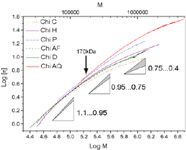Characterization of Chitosan by Triple Detection Size Exclusion Chromatography (TD-SEC)
Malvern Instruments Ltd.
Malvern Instruments Ltd.
Chitosan samples from different sources are fully characterized for molecular weight, intrinsic viscosity, and molecular structure by triple detection size exclusion chromatography (TD-SEC).
The linear polysaccharide chitin is one of the most abundant natural materials in the world and composes most of the exoskeleton of anthropods and the radula of molluscs. Chitin is insoluble in water but once deacetylated, the resulting form, chitosan, can be dissolved in acetic acid. Chitosan is bio-degradable over time, making it an inexpensive and abundant eco-friendly material.
Chitosan Samples
Six chitosans from various sources were obtained (1) and the degree of acetylation was determined by 1H-NMR measurements as explained in reference 2. The sample information is shown in the table.

Properties of the various chitosans, as measured by TD-SEC
Experimental Conditions
Triple detection size exclusion chromatography (TD-SEC) was performed at 30 °C using a Viscotek TDAmax system, two Viscotek ViscoGEL columns, and a mobile phase consisting of 0.3 M acetic acid and sodium acetate buffer at 0.7 mL/min.
The chitosan samples were prepared at 0.3 to 1 mg/mL, dissolved for 24 h under light agitation, and then filtered using a 0.45 μm filter prior to injection.
Results
The data is separated into two groups of three. The first three samples have a comparable fraction of acetylaction of about 0.05 and the second group around 0.10 but show different molecular weights.
Using TD-SEC, the intrinsic viscosity and the molecular weight were measured for each elution slice. The Mark-Houwink plot (M-H plot) is given for all the chitosan samples in Figure 1. For molecular weights below 170 kDa, the slope of the M-H plot is around 1.0 for all chitosans, indicating similar densities/coiling. The difference in slope is noted for molecular weights above 170 kDa where there is a curvature in the M-H plot. The change of slope is due to a change to tighter polymer coiling at high molecular weight.

Figure 1: Mark-Houwink plot for all the chitosan samples.
Conclusion
Accurate molecular weights and molecular weight distributions were measured using triple detection. The degree of acetylation did not correlate with the molecular weight, inferring that it is possible to have highly acetylated chitosan with low or high molecular weights. The viscometer was used to correlate the molecular weight to the size of the chitosan, and this proved that the use of Ubbelhode-type viscometric measurements to estimate the molecular weight are flawed as the M-H curve exhibits a curvature.
References
(1) Application Note MRK1295-01, Malvern Instruments Knowledgebase article.
(2) M.X. Weinhold, J.C.M. Sauvageau, N. Keddig, M. Matzke, B. Tartsch, I. Grunwald, C. Kübel, B.Jastorff, and J. Thöming, Green Chem.11, 498 (2009).
Malvern Instruments Ltd.
Enigma Business Park, Grovewood Road,Malvern, UK
tel. +44 (0) 1684 892456
Website: www.malvern.com

SEC-MALS of Antibody Therapeutics—A Robust Method for In-Depth Sample Characterization
June 1st 2022Monoclonal antibodies (mAbs) are effective therapeutics for cancers, auto-immune diseases, viral infections, and other diseases. Recent developments in antibody therapeutics aim to add more specific binding regions (bi- and multi-specificity) to increase their effectiveness and/or to downsize the molecule to the specific binding regions (for example, scFv or Fab fragment) to achieve better penetration of the tissue. As the molecule gets more complex, the possible high and low molecular weight (H/LMW) impurities become more complex, too. In order to accurately analyze the various species, more advanced detection than ultraviolet (UV) is required to characterize a mAb sample.

.png&w=3840&q=75)

.png&w=3840&q=75)



.png&w=3840&q=75)



.png&w=3840&q=75)














